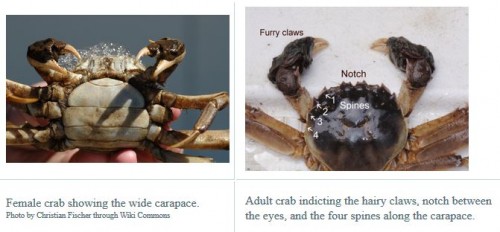Tracking the Invasive Chinese Mitten Crab through the Chinese Mitten Crab Watch

When you go outside on a cold and snowy day you put on a coat and mittens to keep you warm, but did you know that there’s a type of crab that actually wears mittens all year round? It’s called the Chinese Mitten Crab (Eriocheir sinensis). These crabs are yellowish brown and have six walking legs and two claws that are covered in furry fuzz (the male’s claws are especially fuzzy). Mitten crabs range in size from 5-10 cm across the top shell and they have 4 lateral spines on each side of the shell. Smithsonian scientists are worried about these crabs because they have become invasive from Asia to North America and Europe. In China these crabs are considered a delicacy. It is thought that they first came to the US either in the ballast water of ships (water in the hull of a ship that keeps it upright) coming from Asia or possibly in the food trade.

So, what’s the big deal about little crabs with mittens?
The big deal behind mitten crabs is that they can have some really negative impacts on the ecology of fresh water and marine ecosystems. These types of crabs are called catadromous (cat-ad-ra-mus), which means that during their juvenile years they live in fresh water and in their adult years they move to salty or brackish waters; this is a double-whammy for those trying to protect wetlands and waterways. Mitten crabs also tend to move en-masse (in large groups) when they travel from fresh to salt water. This movement can clog fishing nets, pipes, and water intake systems.

Mitten crabs are omnivorous feeders and they’ll eat just about anything. If they invade non-native waters they have the ability to effect food webs by eating aquatic plants, detritus, fish, fish eggs, micro and marcro invertebrates, algae, and even other crabs. By eating the food of native species fish, crabs, and invertebrates these mitten wielding arthropods have the ability to unbalance entire food webs. Another big issue is that when the crabs move into creeks and rivers they burrow into the sides of the waterways. This causes accelerated erosion and weakening of levees and flood control efforts. Land managers in Germany have already had to deal with the repercussions of mitten crab destabilization of dams and waterways. As if all this wasn’t enough, the mitten crabs can also carry a version of the Oriental lung fluke, which can be passed on to humans that eat them.
Where are they, and what can we do?
Most of the early sightings of mitten crabs have been in waterways along the West Coast of North America, in California and the San Francisco Bay Area (in the 1980’s). They have recently been found in the Chesapeake Bay near Baltimore Maryland. Researchers from the Smithsonian Environmental Research Center and other groups from around the US are trying to track the abundance and distribution of this invader. You can help by joining the Mitten Crab Watch.
Steps to take if you find a mitten crab-
- Do not throw it back! Keep it contained and away from any body of water.
- Take close up photos of the crab a ruler in the picture if possible.
- Note the precise location (long/lat) the crab was found, date, and time.
- Freeze the animal and put it on ice in a freezer or cooler.
- Report the mitten crab sighting by submitting all this information and photos to SERCMittenCrab@si.edu. Researchers will get back to you immediately.
If you have questions you can always call the Mitten Crab Hotline (443) 482.2222.
You can also upload your sightings on the Citizen Science website Project Noah by joining the Mitten Crab Watch mission. Scientists need the power of crowd sourcing and citizen science to watch out for these invaders. You can help by joining the effort.

